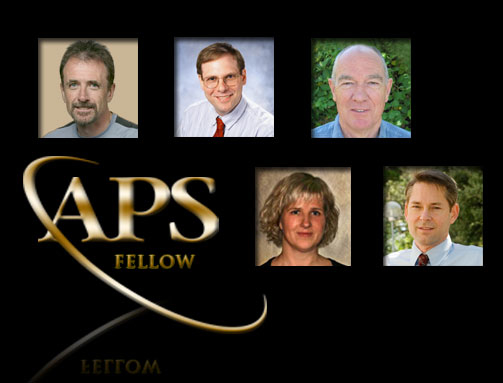Five LLNL researchers named APS fellows
 (Download Image)
Clockwise from left, David Bradley, Laurence Fried, Arthur Molvik, Scott Wilks and Christine Orme.
(Download Image)
Clockwise from left, David Bradley, Laurence Fried, Arthur Molvik, Scott Wilks and Christine Orme.
David K. Bradley , a physicist in the Shock Physics Group of the Physics Division of the Physical and Life Sciences Directorate, has been at the Lab for 11 years. He was honored for "the development and use of high speed optical and X-ray instrumentation to discover new phenomena in high-energy density plasmas."
"I was pleasantly surprised," Bradley said. "I was not expecting it. It's quite an honor to be recognized by one's peers."
Laurence Fried , the Extreme Chemistry group leader in the Chemical Sciences Division of the Physics and Life Sciences Directorate, has been at LLNL 17 years. He was recognized for "outstanding contributions to the physics and chemistry of shocked materials, the high pressure, high temperature equations of state of solids and liquids, and the prediction of energetic material reactivity, most notably the existence of sub-picosecond chemistry in high temperature dense fluids."
"The APS fellowship represents an acknowledgement by scientific peers of significant contributions to physics," Fried said. "I feel very lucky to be a part of LLNL's stimulating multidisciplinary research environment."
Arthur Molvik, a Lab retiree since July 2007, worked in the Fusion Energy Program of Physics. He was honored for "outstanding contributions to diverse areas of plasma physics and technology, including MHD stability limits in mirrors, and the physics of gas and electron accumulation in the ion accelerators."
"It is exciting to receive recognition for the work done over so many years," he said. "I have been surrounded by many good people."
Christine Orme, who joined the Lab in 1996, is a staff scientist in the Biosciences and Biotechnology Division of the Physical and Life Sciences Directorate. She was honored for her "outstanding contributions in understanding the fundamental physics of crystallization and materials assembly with application to biomineralizaion, biomimetic synthesis, and shape control of nanostructures."
Scott Wilks , a research scientist in the Physics Division of the Physical and Life Sciences Directorate, has been with the Lab for 21 years. He was honored for "pioneering contributions to the understanding of intense and ultra-intense laser plasma interactions and their applications to high-energy density science, including fast ignition, ion acceleration and positron generation."
"Being elected a fellow is more than a personal achievement," Wilks said. "It also is recognition of the mentors and colleagues that I've worked with over the years and a testament to the excellent research environment that the Lab provides for its scientists."
APS fellowships are a distinct honor given after extensive review. Election to APS fellowship is limited to no more than one half of one percent of APS's membership for a given year. Receiving a fellowship reflects the honor and approbation of one's professional peers. This year, more than 200 members were elected APS fellows.
For more information about APS fellowships, go to the Fellowship Website.




